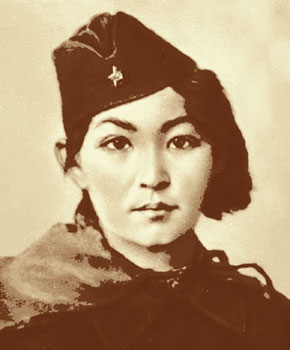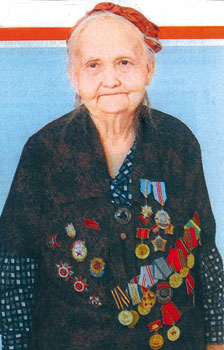
Aliya Moldagulova, national hero of Kazakhstan.
Kazakh people have always admired their daughters for their beauty, intelligence and courage. The women of the great steppe always held high status in the socio-political hierarchy of Kazakh governments. In Kazakhstan’s nomadic tradition, women have always been equal to men in everything, including work and war.
Women have been powerful in what is now Kazakhstan since the early Iron Age, when women joined men on the battlefield. The percentage of female warriors fluctuated at times, but they were always present.
Queen Tomyris is one of the earliest examples of a woman in a position of great prominence. Having lost her husband and son, the Saka-Massagetae Queen Tomyris (approximately 570-520 B.C.) was able to lead her nation and her people and protect their native land. The famous story of the victory of Tomyris over the Persian King Cyrus still inspires writers, movie directors and artists.
Another Saka Queen, Zarina (about 558-518 B.C.), killed her husband to ensure peaceful relations with their stronger neighbour, the Medes, and preserved the integrity and independence of the nation. In gratitude, the Saka people built her a pyramid topped with a gold statue after her death. Kazakhstan’s medieval history consists of numerous invasions and wars. Invaders always coveted the rich land, countless flocks, fertile fields and thriving cities. Hero-batyrs had to stand up for their native land. Oral folklore and other chronicles have preserved the names of many women-batyrs. The wife of Karakerey Kabanbay-batyr, Gaukhar-batyr, was also his ally in combat. Their daughter Nazim-batyr continued in their footsteps and defended her clan against the Dzhungars.
In the Aktobe region there is a mausoleum in honour of Botagoz-batyr (about 1667-1757), daughter of Yeset-Tarkhan. Botagoz became famous for defending her clan’s lands with her brothers against the raids of the Kalmyks. According to legend, the Kalmyks killed her father, and she immediately assembled a squad of 150 dzhigits (horse riders and fighters), defeated the Kalmyks and returned relatives and cattle that had been held prisoner.

Фото Сергея Бондаренко, Болатбека Отарбаева
During World War II, Kazakh women worked in the rear and went to the front to protect their motherland from the Nazis. Of all the women of the Soviet East, it was two women from Kazakhstan, machine gunner Manshuk Mametova and sniper Alia Moldagulova, who were posthumously awarded the highest award of the Soviet Union, the title of Hero of the Soviet Union, for their feats in battle.Mametova was only 20 years old when she decided to go to the front. At first she was a clerk of military staff; while at the front she finished the machine gunners’ course. In 1943, during heavy fighting for the liberation of Nevel City, she killed 70 enemy soldiers before dying from shrapnel wounds.
In 1942, Alia Moldagulova asked to join the army at the front, but because she was not yet 18 years old, she was sent to study shooting. A year later she was fighting at the front; a year after her arrival at the front, she was killed in battle.
Altynshash Nurgozhinova was posthumously awarded the Order of the Red Star for her heroism. At the expense of her life, she saved a Soviet squad from being surrounded. Kazakh women-partisans Nurganym Bayseitova, Turgash Zhumabayeva and Zhamal Agadilova also defended the Soviet Union.
Hiuaz Dospanova was the only Kazakh woman pilot of World War II. For her courage and bravery she was awarded the Orders of the Red Star and of the Red Banner. Dospanova flew more than 300 mission sorties. The brave pilot was twice seriously wounded, but she rejoined the ranks and was on hand for the victory in Berlin. In 2004, President of Kazakhstan Nursultan Nazarbayev awarded Hiuaz Dospanova the title of Khalyk Kaharmany (Hero of Kazakhstan).
“Kazakhstan, through the activity of its female population, took 31st place among 134 countries in the World Economic Forum’s ratings of gender equality,” Advisor to the President and Chair of the National Commission for Women, Family and Demographic Policy Gulshara Abdykalikova reported recently at the national meeting of the chairs of regional politicians’ clubs.


